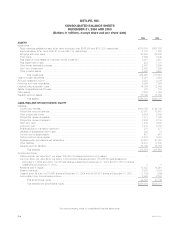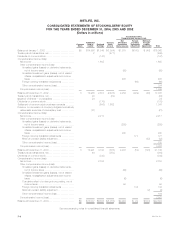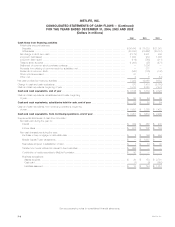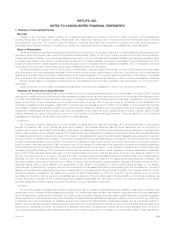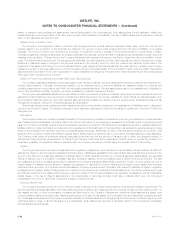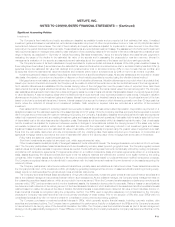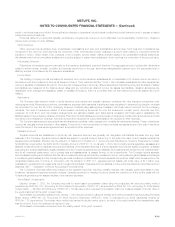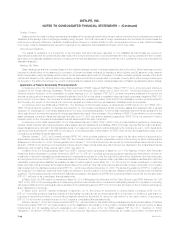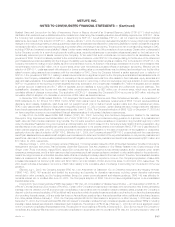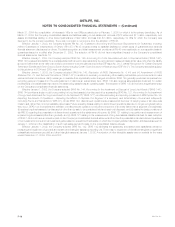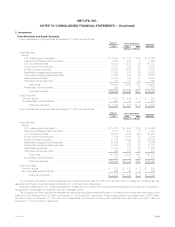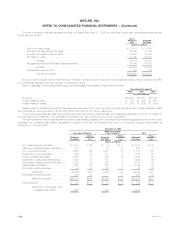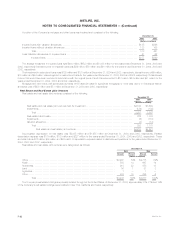MetLife 2004 Annual Report Download - page 55
Download and view the complete annual report
Please find page 55 of the 2004 MetLife annual report below. You can navigate through the pages in the report by either clicking on the pages listed below, or by using the keyword search tool below to find specific information within the annual report.METLIFE, INC.
NOTES TO CONSOLIDATED FINANCIAL STATEMENTS — (Continued)
primary beneficiary of these entities based on the framework provided in FIN 46(r). Prior to the adoption of FIN 46(r), such SPEs were not consolidated
because they did not meet the criteria for consolidation under previous accounting guidance. These beneficial interests are generally structured notes,
which are included in fixed maturities, and their income is recognized using the retrospective interest method or the level yield method, as appropriate.
Impairments of these beneficial interests are included in net investment gains (losses).
Derivative Financial Instruments
Derivatives are financial instruments whose values are derived from interest rates, foreign exchange rates, or other financial indices. Derivatives may
be exchange traded or contracted in the over-the-counter market. The Company uses a variety of derivatives, including swaps, forwards, futures and
option contracts, to manage its various risks. Additionally, the Company enters into income generation and replication derivatives as permitted by its
insurance subsidiaries’ Derivatives Use Plans approved by the applicable state insurance departments. Freestanding derivatives are carried on the
Company’s consolidated balance sheet either as assets within Other invested assets or as liabilities within Other liabilities at fair value as determined by
quoted market prices or through the use of pricing models. Values can be affected by changes in interest rates, foreign exchange rates, financial indices,
credit spreads, market volatility, and liquidity. Values can also be affected by changes in estimates and assumptions used in pricing models. If a derivative
does not qualify for hedge accounting pursuant to Statement of Financial Accounting Standards (‘‘SFAS’’) No. 133, Accounting for Derivative Instruments
and Hedging Activities (‘‘SFAS 133’’), as amended, changes in the fair value of the derivative are reported in Net investment gains (losses), or in Interest
credited to policyholder account balances for hedges of liabilities embedded in certain variable annuity products offered by the Company.
To qualify for hedge accounting, at the inception of the hedging relationship, the Company formally documents its risk management objective and
strategy for undertaking the hedging transaction, as well as its designation of the hedge as either (i) a hedge of the fair value of a recognized asset or
liability or an unrecognized firm commitment (‘‘fair value hedge’’); (ii) a hedge of a forecasted transaction or of the variability of cash flows to be received or
paid related to a recognized asset or liability (‘‘cash flow hedge’’); or (iii) a hedge of a net investment in a foreign operation. In this documentation, the
Company sets forth how the hedging instrument is expected to hedge the risks related to the hedged item and sets forth the method that will be used to
retrospectively and prospectively assess the hedging instrument’s effectiveness and the method which will be used to measure ineffectiveness. A
derivative designated as a hedging instrument must be highly effective in offsetting the designated risk of the hedged item. Hedge effectiveness is
formally assessed at inception and throughout the life of the hedging relationship. The ineffective portion of the changes in fair value of the hedging
instrument is recorded in Net investment gains (losses).
Under a fair value hedge, changes in the fair value of the derivative, along with changes in the fair value of the hedged item related to the risk being
hedged, are reported in Net investment gains (losses).
In a cash flow hedge, changes in the fair value of the derivative are recorded in Other comprehensive income (loss), a separate component of
shareholders’ equity, and the deferred gains or losses on the derivative are reclassified into the income statement when the Company’s earnings are
affected by the variability in cash flows of the hedged item.
In a hedge of a net investment in a foreign operation, changes in the fair value of the derivative are recorded in Other comprehensive income (loss).
The Company discontinues hedge accounting prospectively when: (i) it is determined that the derivative is no longer highly effective in offsetting
changes in the fair value or cash flows of a hedged item; (ii) the derivative expires or is sold, terminated, or exercised; (iii) it is no longer probable that the
forecasted transaction will occur; (iv) a hedged firm commitment no longer meets the definition of a firm commitment; or (v) the derivative is de-designated
as a hedging instrument.
When hedge accounting is discontinued because it is determined that the derivative is not highly effective in offsetting changes in the fair value or
cash flows of a hedged item, the derivative continues to be carried on the consolidated balance sheet at its fair value, with changes in fair value
recognized currently in Net investment gains (losses). The carrying value of the hedged recognized asset or liability under a fair value hedge is no longer
adjusted for changes in its fair value due to hedged risk, and the cumulative adjustment to its carrying value is amortized into income over the remaining
life of the hedged item. The changes in fair value of derivatives recorded in Other comprehensive income (loss) related to discontinued cash flow hedges
are amortized into income over the remaining life of the hedging instruments.
When hedge accounting is discontinued because it is probable that the forecasted transactions will not occur by the end of the specified time period
or the hedged item no longer meets the definition of a firm commitment, the derivative continues to be carried on the consolidated balance sheet at its fair
value, with changes in fair value recognized currently in Net investment gains (losses). Any asset or liability associated with a recognized firm commitment
is derecognized from the consolidated balance sheet, and recorded currently in Net investment gains (losses). Deferred gains and losses of a derivative
recorded in Other comprehensive income (loss) pursuant to the cash flow hedge of a forecasted transaction are recognized immediately in Net
investment gains (losses).
In all other situations in which hedge accounting is discontinued, the derivative is carried at its fair value on the consolidated balance sheet, with
changes in its fair value recognized in the current period as Net investment gains (losses).
The Company is also a party to financial instruments in which a derivative is ‘‘embedded.’’ For each financial instrument in which a derivative is
embedded, the Company assesses whether the economic characteristics of the embedded derivative are clearly and closely related to those of the host
contract, and determines whether a separate instrument with the same terms as the embedded instrument would meet the definition of a derivative, as
defined in SFAS 133. If it is determined that the embedded derivative possesses economic characteristics that are not clearly and closely related to the
economic characteristics of the host contract, and that a separate instrument with the same terms would qualify as a derivative instrument, the
embedded derivative is separated from the host contract and accounted for as a freestanding derivative. Such embedded derivatives are carried on the
consolidated balance sheet at fair value with the host contract and changes in their fair value are reported currently in Net investment gains (losses). If the
Company is unable to properly identify and measure an embedded derivative for separation from its host contract, the entire contract is carried on the
balance sheet at fair value, with changes in fair value recognized in the current period in Net investment gains (losses).
MetLife, Inc.
F-12




